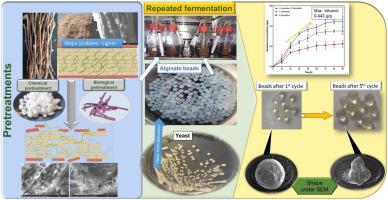Industrial Crops and Products ( IF 5.6 ) Pub Date : 2020-11-23 , DOI: 10.1016/j.indcrop.2020.113122 Kamran Malik , El-Sayed Salama , Marwa M. El-Dalatony , Mohammed Jalalah , Farid A. Harraz , M.S. Al-Assiri , Yuanzhang Zheng , Priyanka Sharma , Xiangkai Li

|
The main concern of lignocellulosic biomass utilization for biofuel production is the presence of lignin which hinder the hemicellulose and cellulose accessibility. In this study, chemical and biological pretreatments have been used for decomposition of the lignocellulosic cotton stalk (CS) into monosaccharides. Long-term fermentation/co-fermentation (upto 5 cycles) of pretreated CS by immobilized yeasts (Saccharomyces cerevisiae YPH499 and Pachysolen tannophilus 32691) for bioethanol was investigated. Spectroscopic analysis (including FTIR, XRD, SEM, and TGA) showed the disintegration and abrasion in CS structure after application of both the pretreatments. The maximum sugar utilization efficiency in 1st cycle of co-fermentation by immobilized yeasts was 94.1 and 90.4% with 0.46 and 0.44 g/g bioethanol production in chemical and biological pretreatment, respectively. Moreover, bioethanol yield was slightly sustained till 2nd cycle (0.38−0.40 g/g). However, bioethanol production steadily declined at 3rd cycle and reached to the lowest value at 5th cycle. These results demonstrated that co-fermentation with immobilization approach might significantly improve the bioethanol production from pretreated lignocellulosic biomass (including CS).
中文翻译:

固定化酵母的共同发酵促进了预处理棉秆木质纤维素生物质的生物乙醇生产:长期研究
木质纤维素生物质用于生物燃料生产的主要问题是木质素的存在,木质素阻碍了半纤维素和纤维素的可及性。在这项研究中,化学和生物预处理已用于将木质纤维素棉秆(CS)分解为单糖。固定化酵母(酿酒酵母YPH499和Pachysolen tannophilus)对预处理过的CS的长期发酵/共发酵(最多5个循环)32691)用于生物乙醇。光谱分析(包括FTIR,XRD,SEM和TGA)显示,两种预处理均会导致CS结构的崩解和磨损。在固定化酵母共发酵的第一个循环中,在化学和生物预处理中最大的糖利用效率分别为94.1%和90.4%,其中生物乙醇的产量分别为0.46和0.44 g / g。此外,直到第二个循环(0.38-0.40 g / g),生物乙醇的产量仍略有维持。但是,生物乙醇产量在第3个周期稳定下降,并在第5个周期达到最低值。这些结果表明,与固定化方法共同发酵可能会显着提高预处理木质纤维素生物质(包括CS)的生物乙醇产量。











































 京公网安备 11010802027423号
京公网安备 11010802027423号